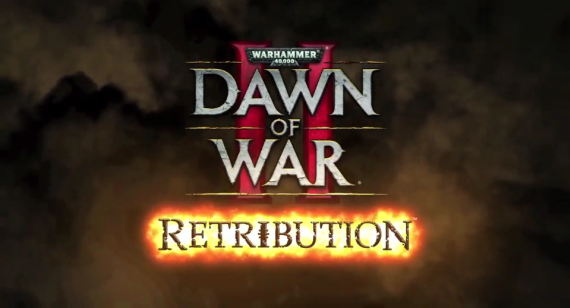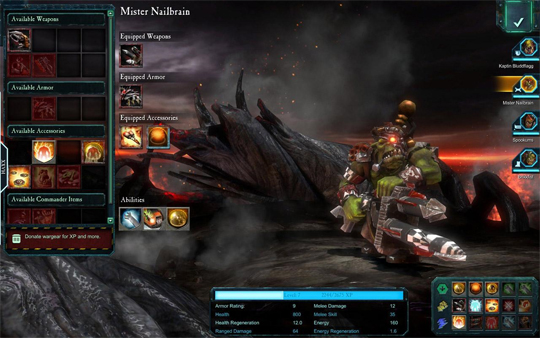
Dawn of War II has made a name for itself as being the unorthodox RTS game. Instead of focusing on base building and following your way up the tech tree like standard RTS games, Dawn of War II focuses on unit-specific tactics like cover, unit facing, and hero powers, and combines that focus with role-playing tropes such as experience and equipment. It was great fun in the original Dawn of War II, was expanded on in the first standalone expansion, Chaos Rising, and has now finally been perfected in the newest standalone expansion, Retribution. While the gameplay is finely tuned to deliver straight fun into your pleasure center, this is still Dawn of War II, though, making this trip into the Warp feel all too familiar.
The biggest change here is that the campaign can now be played through with one of six Warhammer 40K factions: Tyranids, Space Marines, Chaos Marines, Imperial Guard, Orks, and Eldar. Each faction runs through the same ten to twelve missions throughout its campaign, from that specific faction’s point of view. This means that you’ll be running through the same levels, environments, and mission structure in more than one campaign. While this may sound repetitive, the factions all play differently enough that running though it with each will produce a unique enough experience and set of strategies. Orks are built to overrun their opponents and build up their "Waaagh!" meter, while a smaller faction like the Imperial Guard uses long-range weaponry, tough vehicles, and hit-and-run tactics. There are also interesting enough set pieces sprinkled throughout the campaign in both the regular levels and faction-specific ones that make the entire experience worth trekking through multiple times.
The second biggest change to the campaign is the ability to capture HQs and build more units mid-level. In the two previous Dawn of War II games, you started each mission with a set squad of hero units of your choosing. Each hero unit filled a set role, such as tank, melee, DPS, or stealth. This usually meant that you employed the same strategy in most of the levels, using the tank to draw fire, while the heavy weapons guys set up in cover, or the stealth team snuck around and set up ambushes and booby traps. Now, in Retribution, you can choose to deploy with either hero units or honor guard units. Hero units are the same as before, but honor guard units are special squads that can be built for free at the HQ and come with special abilities like being able to increase your unit cap or boosting other smaller units. This level of strategy is further expanded by being able to build new units mid-mission, letting you customize your force to your play style or reinforce your heroes.

Character progression has also been streamlined. Every point added to a character unlocks a new ability, with about 6 abilities per tech tree, instead of the prolonged stat building of the previous games. Wargear has also been scaled back in favor of new units or unit upgrades as awards. Instead of swimming in new weapons and armor, the game narrows it down and makes the items you do receive that much more powerful and valuable.
After you’re done banishing demons and stomping humans, you can jump into multiplayer, which is now supported by Steamworks instead of Games for Windows Live. As such, multiplayer matchmaking is much smoother and it is much easier to make it into a game. The player count is always stated on the front page and a quick click will get you into a lobby to chat with other players.
Competitive multiplayer in Retribution is largely the same as in the previous games with Victory Point, Annihilation, and Free for All returning in 1v1 to 3v3 variants. Annihilation is solid offering, especially when played with more than one vs. one, but Victory Point just feels like a grandiose version of a carousel ride. It requires you to capture special nodes on the map that subtract from your opponents’ point total. The more nodes you have under your control, the more points your opponent loses. This setup often results in devolved matches in which both players constantly circle the map and capture nodes, with the victor usually being the person who got the early start. It’s tedious, frustrating, and something I avoid altogether.

Last Stand, on the other hand, is the crown jewel of the multiplayer package. It takes the persistence of most modern FPS games and adds it to the RTS genre. Here, three players team up to take on waves of enemies in an arena. As you kill enemies, you add to your team’s score multiplier and gain experience, which will unlock more Wargear for you to use. It requires teamwork, persistence, and is a ton of fun.
Technically, the game is excellent. The graphics and sound have been enhanced greatly. Character models look amazing and I found myself zooming in all the way in just to see the way units move and react. The animations are fluid and improved, with characters performing certain kill animations, like Orks grabbing smaller characters and slamming them into the floor. The physics have also been improved, with characters being knocked into walls or their jetpacks malfunctioning and the unit flying haphazardly until they blow up. This is all enhanced by the aforementioned sound, making Retribution an audio/visual feast.
If Retribution displays any faults, it’s that it’s still Dawn of War II. Even though the campaign has changed things up, the whole package still feels familiar and much like the original 2009 game, blemishes and all. This isn’t an indictment; Dawn of War II is still one of the best RTS games and one of my favorite games, of which Retribution feels like a loving send off.
Now hurry up, Relic. We need Dawn of War III.


















